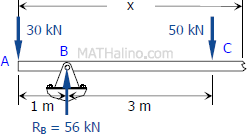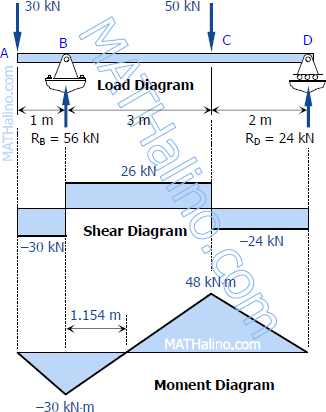From the load diagram:
ΣMB=0
5RD+1(30)=3(50)
RD=24kN
ΣMD=0
5RB=2(50)+6(30)
RB=56kN
 Segment AB:
Segment AB:
VAB=−30kN
MAB=−30xkN⋅m
 Segment BC:
Segment BC:
VBC=−30+56
VBC=26kN
MBC=−30x+56(x−1)
MBC=26x−56kN⋅m
 Segment CD:
Segment CD:
VCD=−30+56−50
VCD=−24kN
MCD=−30x+56(x−1)−50(x−4)
MCD=−30x+56x−56−50x+200
MCD=−24x+144kN⋅m
 To draw the Shear Diagram:
To draw the Shear Diagram:
- In segment AB, the shear is uniformly distributed over the segment at a magnitude of -30 kN.
- In segment BC, the shear is uniformly distributed at a magnitude of 26 kN.
- In segment CD, the shear is uniformly distributed at a magnitude of -24 kN.
To draw the Moment Diagram:
- The equation MAB = -30x is linear, at x = 0, MAB = 0 and at x = 1 m, MAB = -30 kN·m.
- MBC = 26x - 56 is also linear. At x = 1 m, MBC = -30 kN·m; at x = 4 m, MBC = 48 kN·m. When MBC = 0, x = 2.154 m, thus the moment is zero at 1.154 m from B.
- MCD = -24x + 144 is again linear. At x = 4 m, MCD = 48 kN·m; at x = 6 m, MCD = 0.
